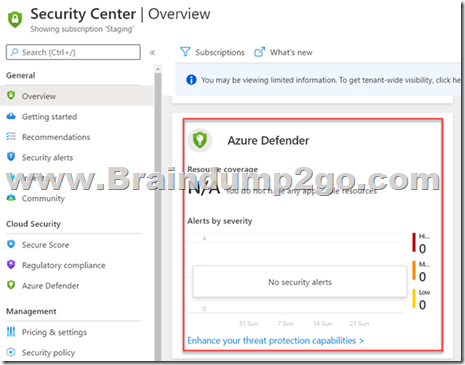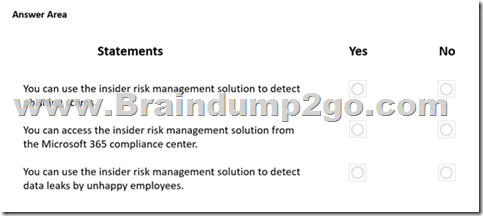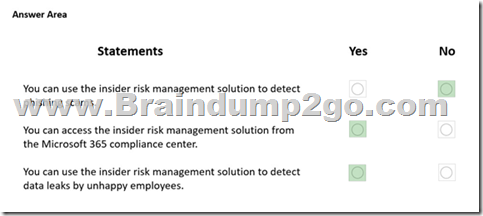[June-2023]Exam SC-900 VCE and SC-900 PDF Dumps SC-900 152Q Free Offered by Braindump2go[Q55-Q110]
June/2023 Latest Braindump2go SC-900 Exam Dumps with PDF and VCE Free Updated Today! Following are some new Braindump2go SC-900 Real Exam Questions!
QUESTION 55
You are considering the use of sensitivity labels in Microsoft 365. Can sensitivity labels can be used to encrypt the contents in documents?
A. Yes
B. No
Answer: A
Explanation:
When you apply a “Confidential” label to a document, the label will encrypt the content in the document.
Reference:
https://docs.microsoft.com/en-us/microsoft-365/compliance/sensitivity-labels?view=o365-worldwide
QUESTION 56
You are planning on making use of the Azure Bastion service. Can you use the Azure Bastion service to restrict traffic from the Internet onto an Azure virtual machine?
A. Yes
B. No
Answer: B
Explanation:
You cannot use the Azure Bastion service to restrict traffic into an Azure virtual machine. For this you will need to use Network Security groups. The Azure Bastion service is used to RDP/SSH into an Azure virtual machine via the Azure portal and the browser.
Reference:
https://docs.microsoft.com/en-us/azure/bastion/bastion-overview
QUESTION 57
You are looking at the capabilities of Azure Active Directory. Can you use Azure Active Directory to manage device registrations in Azure Active Directory?
A. Yes
B. No
Answer: A
Explanation:
https://docs.microsoft.com/en-us/azure/active-directory/devices/overview
QUESTION 58
Your company is planning on using Azure Cloud services. Which of the following can be used to ensure that data can be read only by authorized users?
A. Encryption
B. Deduplication
C. Archiving
D. Compression
Answer: A
Explanation:
You can ensure data is encrypted. Then only authorized users would have the encryption key. The encryption key can then be used to decrypt and read the data.
Reference:
https://docs.microsoft.com/en-us/microsoft-365/compliance/office-365-encryption-in-the-microsoft-cloud-overview?view=o365-worldwide
QUESTION 59
Your company is planning on using Azure Active Directory for the storage of identities. They want to make use of the self-service password reset feature.
Which of the following authentication methods are available for self-service password reset? Choose 3 answers from the options given below
A. Email
B. A passport identification number
C. A picture message
D. Mobile app notification
E. Mobile app code
Answer: ADE
Explanation:
Below are the authentication methods available for self-service password reset:
Mobile app notification
Mobile app code
Email
Mobile phone
Office phone
Security questions
Reference:
https://docs.microsoft.com/en-us/azure/active-directory/authentication/concept-sspr-howitworks
QUESTION 60
Your company wants to start making use of Azure. They are looking at different security aspects when it comes to using Azure.
Which of the following could be used for the following requirement?
– Enforce Multi-Factor authentication based on the sign-in risk
A. Azure AD Identity Management
B. Azure Conditional Access
C. Azure AD Roles
D. Azure AD Connect
Answer: A
Explanation:
In Azure AD Identity Protection, you can configure the Sign-in risk policy to allow access and enforce the use of Multi-Factor Authentication.

Reference:
https://docs.microsoft.com/en-us/azure/active-directory/identity-protection/overview-identity-protection
QUESTION 61
Which of the following is a scalable, cloud-native, security information event management and security orchestration automated response solution?
A. Azure Sentinel
B. Azure Security Center
C. Azure Active Directory
D. Azure AD Identity Protection
Answer: A
Explanation:
You can use Azure Sentinel as a scalable, cloud-native, security information event management and security orchestration automated response solution. Azure Sentinel has the capability to ingest data from a variety of sources and performance threat monitoring on that data.
Reference:
https://docs.microsoft.com/en-us/azure/sentinel/overview
QUESTION 62
Which of the following provides advanced and intelligent protection of Azure and hybrid resources and workloads?
A. Azure Defender
B. Azure Policies
C. Azure Blueprints
D. Azure Active Directory
Answer: A
Explanation:
With Azure Defender , you can enable intelligent protection of your resources that are defined in Azure and also in your on-premises infrastructure.
This is an additional security feature that comes as part of Azure Security Center as shown below

Reference:
https://docs.microsoft.com/en-us/azure/security-center/azure-defender
QUESTION 63
Which of the following is available for the Azure Application Gateway service that helps to protect web applications from common exploits and vulnerabilities?
A. Azure Firewall
B. Azure Web Application Firewall
C. Azure Policy
D. Azure Identity Protection
Answer: B
Explanation:
The Azure Web Application Firewall can be used along with the Azure Application Gateway resource to protect web applications from common exploits and vulnerabilities. It can help to protect against attacks such as SQL injection attacks or cross-site scripting attacks.
Reference:
https://docs.microsoft.com/en-us/azure/web-application-firewall/ag/ag-overview
QUESTION 64
You are evaluating the different services available in Azure when it comes to security. Which of the following can be accomplished with the use of the Azure Privileged Identity Managed service?
A. Filter traffic to Azure virtual machines
B. Enable Multi-Factor Authentication for users based on detected sign-in risks
C. Provide just-in-time access to resource roles in Azure
D. Measure the security posture of resources defined in an Azure environment
Answer: C
Explanation:
With Azure Privileged Identity Managed , you can provide just-in-time access to Azure AD roles and resource roles. Here users can request for access whenever required. And the access can be granted or denied accordingly.
Reference:
https://docs.microsoft.com/en-us/azure/active-directory/privileged-identity-management/pim-configure
QUESTION 65
You are evaluating the different discovery tools that are available with Microsoft 365. You need to map the tool that can be used for desired requirement below:
– Be able to quickly find email in Exchange mailboxes
Which of the following would you use for this requirement?
A. Core eDiscovery
B. Advanced eDiscovery
C. Sensitivity labels
D. Content search
Answer: D
Explanation:
The Content search tool can be used to quickly find email in Exchange mailboxes, documents in SharePoint sites and OneDrive locations.
Reference:
https://docs.microsoft.com/en-us/microsoft-365/compliance/search-for-content?view=o365-worldwide
QUESTION 66
You are evaluating the different discovery tools that are available with Microsoft 365. You need to map the tool that can be used for desired requirement below:
– Provide basic capabilities on searching and exporting of content in Microsoft 365
Which of the following would you use for this requirement?
A. Core eDiscovery
B. Privileged Access Management
C. Sensitivity labels
D. Content search
Answer: A
Explanation:
The Core eDiscovery tool helps you to find and export content in Microsoft 365 and Office 365. You can also use the tool to place an eDiscovery hold on certain content locations.
Reference:
https://docs.microsoft.com/en-us/microsoft-365/compliance/get-started-core-ediscovery?view=o365-worldwide
QUESTION 67
In the Microsoft Cloud Adoption Framework for Azure, which two phases are addressed before the Ready phase? Each correct answer presents a complete solution.
NOTE: Each correct selection is worth one point.
A. Plan
B. Manage
C. Adopt
D. Govern
E. Define Strategy
Answer: AE
Explanation:
cloud adoption framework: strategy, plan, ready, adopt, govern, manage.
https://docs.microsoft.com/en-us/azure/cloud-adoption-framework/overview
QUESTION 68
What is an example of encryption at rest?
A. encrypting communications by using a site-to-site VPN
B. encrypting a virtual machine disk
C. accessing a website by using an encrypted HTTPS connection
D. sending an encrypted email
Answer: B
Explanation:
Platform as a Service (PaaS) customer’s data typically resides in a storage service such as Blob Storage but may also be cached or stored in the application execution environment, such as a virtual machine. To see the encryption at rest options available to you, examine the Data encryption models: supporting services table for the storage and application platforms that you use.
QUESTION 69
Which Microsoft 365 feature can you use to restrict communication and the sharing of information between members of two departments at your organization?
A. sensitivity label policies
B. Customer Lockbox
C. information barriers
D. Privileged Access Management (PAM)
Answer: C
Explanation:
Information barriers (IBs) are policies that an admin can configure to prevent individuals or groups from communicating with each other. IBs are useful if, for example, one department is handling information that shouldn’t be shared with other departments.
https://docs.microsoft.com/en-us/microsoft-365/compliance/information-barriers
QUESTION 70
Which three authentication methods does Windows Hello for Business support? Each correct answer presents a complete solution.
NOTE: Each correct selection is worth one point.
A. fingerprint
B. facial recognition
C. PIN
D. email verification
E. security question
Answer: ABC
Explanation:
Windows Hello in Windows 10 enables users to sign in to their device using a PIN.
Windows Hello lets your employees use fingerprint or facial recognition as an alternative method to unlocking a device. With Windows Hello, authentication happens when the employee provides his or her unique biometric identifier while accessing the device-specific Windows Hello credentials.
https://docs.microsoft.com/en-us/windows/security/identity-protection/hello-for-business/hello-why-pin-is-better-than-password
https://docs.microsoft.com/en-us/windows/security/identity-protection/hello-for-business/hello-biometrics-in-enterprise
QUESTION 71
What feature in Microsoft Defender for Endpoint provides the first line of defense against cyberthreats by reducing the attack surface?
A. automated remediation
B. automated investigation
C. advanced hunting
D. network protection
Answer: D
Explanation:
Network protection helps protect devices from Internet-based events. Network protection is an attack surface reduction capability.
Reference:
https://docs.microsoft.com/en-us/microsoft-365/security/defender-endpoint/network-protection?view=o365-worldwide
QUESTION 72
Which two types of resources can be protected by using Azure Firewall? Each correct answer presents a complete solution.
NOTE: Each correct selection is worth one point.
A. Azure virtual machines
B. Azure Active Directory (Azure AD) users
C. Microsoft Exchange Online inboxes
D. Azure virtual networks
E. Microsoft SharePoint Online sites
Answer: AD
Explanation:
Firewall is really not directly protecting the Virtual Networks though DDOS would have been ideal for VNETS.
https://docs.microsoft.com/en-us/azure/firewall/overview
QUESTION 73
You plan to implement a security strategy and place multiple layers of defense throughout a network infrastructure.
Which security methodology does this represent?
A. threat modeling
B. identity as the security perimeter
C. defense in depth
D. the shared responsibility model
Answer: C
Explanation:
Data, Application, Compute, Network, Perimeter, Identity and Access and Physical. Of this physical is more of cloud provider responsibility.
https://docs.microsoft.com/en-us/learn/modules/secure-network-connectivity-azure/2-what-is-defense-in-depth
QUESTION 74
What can you use to scan email attachments and forward the attachments to recipients only if the attachments are free from malware?
A. Microsoft Defender for Office 365
B. Microsoft Defender Antivirus
C. Microsoft Defender for Identity
D. Microsoft Defender for Endpoint
Answer: A
Explanation:
https://docs.microsoft.com/en-us/office365/servicedescriptions/office-365-advanced-threat-protection-service-description
QUESTION 75
Which feature provides the extended detection and response (XDR) capability of Azure Sentinel?
A. integration with the Microsoft 365 compliance center
B. support for threat hunting
C. integration with Microsoft 365 Defender
D. support for Azure Monitor Workbooks
Answer: C
Explanation:
The Microsoft 365 Defender connector for Azure Sentinel (preview) sends all Microsoft 365 Defender incidents and alerts information to Azure Sentinel and keeps the incidents synchronized.
Once you add the connector, Microsoft 365 Defender incidents – which include all associated alerts, entities, and relevant information received from Microsoft Defender for Endpoint, Microsoft Defender for Identity, Microsoft Defender for Office 365, and Microsoft Cloud App Security—are streamed to Azure Sentinel as security information and event management (SIEM) data, providing you with context to perform triage and incident response with Azure Sentinel.
Once in Azure Sentinel, incidents remain bi-directionally synchronized with Microsoft 365 Defender, allowing you to take advantage of the benefits of both the Microsoft 365 Defender portal and Azure Sentinel in the Azure portal for incident investigation and response.
https://docs.microsoft.com/en-us/microsoft-365/security/defender/microsoft-365-defender-integration-with-azure-sentinel?view=o365-worldwide
QUESTION 76
What can you use to provide threat detection for Azure SQL Managed Instance?
A. Microsoft Secure Score
B. application security groups
C. Azure Defender
D. Azure Bastion
Answer: C
Explanation:
https://docs.microsoft.com/en-us/azure/defender-for-cloud/defender-for-cloud-introduction
QUESTION 77
Which Azure Active Directory (Azure AD) feature can you use to restrict Microsoft Intune-managed devices from accessing corporate resources?
A. network security groups (NSGs)
B. Azure AD Privileged Identity Management (PIM)
C. conditional access policies
D. resource locks
Answer: C
QUESTION 78
Which Microsoft 365 feature can you use to restrict users from sending email messages that contain lists of customers and their associated credit card numbers?
A. retention policies
B. data loss prevention (DLP) policies
C. conditional access policies
D. information barriers
Answer: B
Explanation:
https://docs.microsoft.com/en-us/microsoft-365/compliance/dlp-learn-about-dlp?view=o365-worldwide
QUESTION 79
In a Core eDiscovery workflow, what should you do before you can search for content?
A. Create an eDiscovery hold.
B. Run Express Analysis.
C. Configure attorney-client privilege detection.
D. Export and download results.
Answer: A
Explanation:
https://docs.microsoft.com/en-us/microsoft-365/compliance/get-started-core-ediscovery?view=o365-worldwide
QUESTION 80
Which Microsoft portal provides information about how Microsoft manages privacy, compliance, and security?
A. Microsoft Service Trust Portal
B. Compliance Manager
C. Microsoft 365 compliance center
D. Microsoft Support
Answer: A
Explanation:
The Microsoft Service Trust Portal provides a variety of content, tools, and other resources about Microsoft security, privacy, and compliance practices.
https://docs.microsoft.com/en-us/microsoft-365/compliance/get-started-with-service-trust-portal?view=o365-worldwide
QUESTION 81
What can you protect by using the information protection solution in the Microsoft 365 compliance center?
A. computers from zero-day exploits
B. users from phishing attempts
C. files from malware and viruses
D. sensitive data from being exposed to unauthorized users
Answer: D
Explanation:
https://docs.microsoft.com/en-us/microsoft-365/compliance/information-protection?view=o365-worldwide
QUESTION 82
What can you specify in Microsoft 365 sensitivity labels?
A. how long files must be preserved
B. when to archive an email message
C. which watermark to add to files
D. where to store files
Answer: C
Explanation:
https://docs.microsoft.com/en-us/microsoft-365/compliance/sensitivity-labels?view=o365-worldwide
QUESTION 102
You have an Azure subscription.
You need to implement approval-based, time-bound role activation.
What should you use?
A. Windows Hello for Business
B. Azure Active Directory (Azure AD) Identity Protection
C. access reviews in Azure Active Directory (Azure AD)
D. Azure Active Directory (Azure AD) Privileged Identity Management (PIM)
Answer: D
Explanation:
https://docs.microsoft.com/en-us/azure/active-directory/privileged-identity-management/pim-configure
QUESTION 103
Hotspot Question
For each of the following statements, select Yes if the statement is true. Otherwise, select No.
NOTE: Each correct selection is worth one point.

Answer:

Explanation:
https://docs.microsoft.com/en-us/azure/active-directory/conditional-access/overview
https://docs.microsoft.com/en-us/azure/active-directory/conditional-access/howto-conditional-access-policy-admin-mfa
QUESTION 104
When security defaults are enabled for an Azure Active Directory (Azure AD) tenant, which two requirements are enforced? Each correct answer presents a complete solution.
NOTE: Each correct selection is worth one point.
A. All users must authenticate from a registered device.
B. Administrators must always use Azure Multi-Factor Authentication (MFA).
C. Azure Multi-Factor Authentication (MFA) registration is required for all users.
D. All users must authenticate by using passwordless sign-in.
E. All users must authenticate by using Windows Hello.
Answer: BC
Explanation:
Security defaults make it easy to protect your organization with the following preconfigured security settings:
Requiring all users to register for Azure AD Multi-Factor Authentication.
Requiring administrators to do multi-factor authentication.
Blocking legacy authentication protocols.
Requiring users to do multi-factor authentication when necessary.
Protecting privileged activities like access to the Azure portal.
Reference:
https://docs.microsoft.com/en-us/azure/active-directory/fundamentals/concept-fundamentals-security-defaults
QUESTION 105
Which type of identity is created when you register an application with Active Directory (Azure AD)?
A. a user account
B. a user-assigned managed identity
C. a system-assigned managed identity
D. a service principal
Answer: D
Explanation:
When you register an application through the Azure portal, an application object and service principal are automatically created in your home directory or tenant.
Reference:
https://docs.microsoft.com/en-us/azure/active-directory/develop/howto-create-service-principal-portal
QUESTION 106
Which three tasks can be performed by using Azure Active Directory (Azure AD) Identity Protection? Each correct answer presents a complete solution.
NOTE: Each correct selection is worth one point.
A. Configure external access for partner organizations.
B. Export risk detection to third-party utilities.
C. Automate the detection and remediation of identity based-risks.
D. Investigate risks that relate to user authentication.
E. Create and automatically assign sensitivity labels to data.
Answer: CDE
Explanation:
Identity Protection allows organizations to accomplish three key tasks:
– Automate the detection and remediation of identity-based risks.
– Investigate risks using data in the portal.
– Export risk detection data to other tools.
https://learn.microsoft.com/en-us/azure/active-directory/identity-protection/overview-identity-protection
QUESTION 107
You have a Microsoft 365 E3 subscription.
You plan to audit user activity by using the unified audit log and Basic Audit.
For how long will the audit records be retained?
A. 15 days
B. 30 days
C. 90 days
D. 180 days
Answer: C
Explanation:
Microsoft 365 unified auditing helps to track activities performed in the different Microsoft 365 services by both users and admins. Basic auditing is enabled by default for most Microsoft 365 organizations. In the Basic audit, audit records are retained and searchable for the last 90 days.
https://o365reports.com/2021/07/07/microsoft-365-retrieve-audit-log-for-1-year-for-all-subscriptions/
QUESTION 108
To which type of resource can Azure Bastion provide secure access?
A. Azure Files
B. Azure SQL Managed Instances
C. Azure virtual machines
D. Azure App Service
Answer: C
Explanation:
Azure Bastion provides secure and seamless RDP/SSH connectivity to your virtual machines directly from the Azure portal over TLS.
Reference:
https://docs.microsoft.com/en-us/azure/bastion/bastion-overview
QUESTION 109
What are three uses of Microsoft Cloud App Security? Each correct answer presents a complete solution.
NOTE: Each correct selection is worth one point.
A. to discover and control the use of shadow IT
B. to provide secure connections to Azure virtual machines
C. to protect sensitive information hosted anywhere in the cloud
D. to provide pass-through authentication to on-premises applications
E. to prevent data leaks to noncompliant apps and limit access to regulated data
Answer: ACE
Explanation:
https://docs.microsoft.com/en-us/defender-cloud-apps/what-is-defender-for-cloud-apps
QUESTION 110
Hotspot Question
For each of the following statements, select Yes if the statement is true. Otherwise, select No.
NOTE: Each correct selection is worth one point.

Answer:

Explanation:
Box 1: No
Phishing scams are external threats.
Box 2: Yes
Insider risk management is a compliance solution in Microsoft 365.
Box 3: Yes
Insider risk management helps minimize internal risks from users. These include:
Leaks of sensitive data and data spillage
Confidentiality violations
Intellectual property (IP) theft
Fraud
Insider trading
Regulatory compliance violations
Reference:
https://docs.microsoft.com/en-us/microsoft-365/compliance/insider-risk-management?view=o365-worldwide
https://docs.microsoft.com/en-us/microsoft-365/compliance/microsoft-365-compliance-center?view=o365-worldwide
Resources From:
1.2023 Latest Braindump2go SC-900 Exam Dumps (PDF & VCE) Free Share:
https://www.braindump2go.com/sc-900.html
2.2023 Latest Braindump2go SC-900 PDF and SC-900 VCE Dumps Free Share:
https://drive.google.com/drive/folders/1lBjx9vxksSKq1-ok4CmD-HBgZND4cDno?usp=sharing
3.2023 Free Braindump2go SC-900 Exam Questions Download:
https://www.braindump2go.com/free-online-pdf/SC-900-PDF-Dumps(55-110).pdf
Free Resources from Braindump2go,We Devoted to Helping You 100% Pass All Exams!